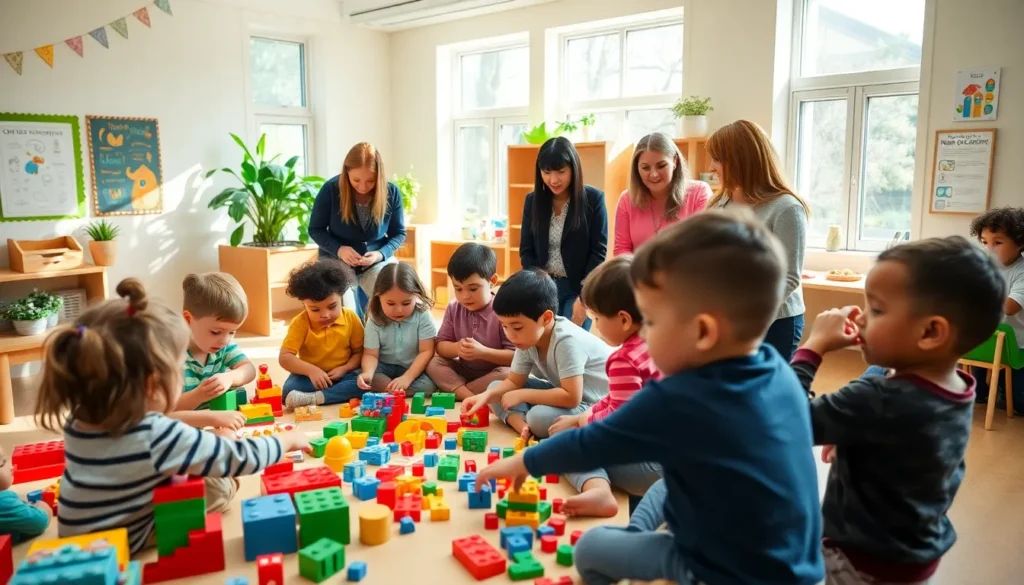Have you ever wondered why Montessori schools seem to have a magic touch when it comes to fostering independent and confident learners? Well, buckle up because we’re diving into the charming world of Greenspring Montessori. This isn’t just any school: it’s an educational oasis that values curiosity and creativity. Whether you’re a curious parent or a potential student, this comprehensive overview will shine a light on what makes Greenspring Montessori stand out. Spoiler alert: It’s a lot more than colorful blocks and happy kids.
Table of Contents
ToggleWhat Is Montessori Education?

Montessori education is more than just a teaching method: it’s a revolutionary approach to learning. Developed by Dr. Maria Montessori in the early 1900s, this educational philosophy emphasizes child-led learning, hands-on experiences, and an environment tailored to individual needs. Imagine a classroom where students direct their own learning, exploring subjects at their own pace while teachers act more as guides than traditional instructors. This method fosters a sense of autonomy and responsibility that prepares children not just for exams but for life itself.
In a Montessori setting, the curriculum is not strictly confined to textbooks. Instead, it encourages exploration through tangible resources like puzzles, building blocks, and art supplies. This interactive learning showcases how each child is unique, tapping into their intrinsic motivations and allowing them to discover their passions.
The Origins of Greenspring Montessori
Founded in the early 1990s, Greenspring Montessori draws inspiration from Dr. Montessori’s concepts while embedding its unique character into the community. Located in the heart of Maryland, this school emerged from a collective dream among educators and parents who sought a nurturing environment that respects each child’s individuality. Its founders were passionate advocates for a holistic approach to education, integrating academics with emotional and social growth.
Over the years, Greenspring Montessori has evolved but remained steadfast in its commitment to providing a robust Montessori environment. The school has developed a solid reputation, not just locally but also throughout the immediate region, thanks to positive reviews from parents and a dedicated teaching staff. In essence, it’s not merely an educational institution: it’s a community built on trust, respect, and a shared mission.
Curriculum and Learning Approach
Greenspring Montessori adopts a customized curriculum that encourages students to engage deeply with various subjects. Unlike traditional schools where subjects may feel disconnected, Greenspring weaves them together, allowing children to see the interrelatedness of knowledge. Subjects like math are taught through practical activities, such as using beads for counting, which leads to a much more tactile understanding of mathematical concepts.
The school focuses on mixed-age classrooms, where younger children learn from older peers, and older children reinforce their knowledge by teaching others. This collaborative atmosphere nurtures empathy, leadership, and social skills. Teachers curate an environment stocked with materials tailored to fit developmental stages, so promoting independent exploration.
Besides, educators continually adapt the curriculum to meet each child’s learning style, making education a personalized journey rather than a one-size-fits-all process.
Benefits of Greenspring Montessori
Choosing Greenspring Montessori presents numerous advantages for both children and their families. One of the most significant benefits is the emphasis on developing critical thinking and problem-solving skills. In a world rife with information, the ability to analyze and apply knowledge creatively is invaluable.
Another fantastic aspect of this educational model is fostering a lifelong love of learning. By allowing children to explore their interests, Greenspring cultivates an atmosphere where learning is pursued joyfully. Also, social and emotional development is prioritized alongside academics, ensuring that children not only excel in their studies but also grow into empathetic individuals.
From enhancing concentration and self-discipline to encouraging collaboration among peers, the benefits of a Montessori education extend far beyond the classroom. Parents often find their children more well-rounded, confident, and capable of discussing complex topics, all essential traits in today’s dynamic world.
Community and Parental Involvement
Greenspring Montessori thrives on its close-knit community, where parents are encouraged to take an active role. Family engagement is a cornerstone of the school’s philosophy. Parents are welcomed into the classroom, contributing their skills and experiences to enrich student learning. Whether it’s sharing a talent, leading a workshop, or simply volunteering, parental involvement enhances the educational experience and strengthens relationships among families.
Through various community events, workshops, and meetings, families come together, share insights, and collaborate on the mission of nurturing their children’s growth. By fostering this cooperative spirit, Greenspring Montessori enables parents to be partners in education, ensuring a cohesive support system for students. This sense of community contributes significantly to children’s social development, making them feel secure and valued.
Admissions Process and Requirements
Navigating the admissions process at Greenspring Montessori is straightforward but requires thoughtful attention. Interested families are encouraged to attend an open house where they can tour the facilities, meet teachers, and ask questions. This initial interaction helps families understand the Montessori approach and whether it aligns with their child’s needs.
Following the open house, interested parties can submit an application along with supporting documents. These typically include a child’s birth certificate, immunization records, and sometimes a recommendation letter from a previous educator, if applicable. The admissions team reviews each application carefully to ensure a good fit between the student and the school.
An interview may be scheduled to discuss the child’s temperament and interests, giving educators insight into how best to support the child’s learning journey. This personalized approach reflects the school’s commitment to ensuring that each child’s needs are met from the very beginning.




